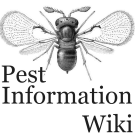Publications for:
pest = Plutella xylostella
crop = Pea (Pisum sativum)
found 10 publications:2021
Fitness comparison of Plutella xylostella on original and marginal hosts using age-stage, two-sex life tablesEcology and Evolution (2021) 11 (14), 9765-9775
publishers website - pestinfo wiki
2019
Variation in performance and resistance to parasitism of Plutella xylostella populationsInsects (2019) 10 (9 - 293)
publishers website - pestinfo wiki
2014
Preference of diamondback moth larvae for novel and original host plant after host range expansionInsects (2014) 5 (4), 793-804
publishers website - pestinfo wiki
2011
Oviposition of diamondback moth in the presence and absence of a novel host plantBulletin of Entomological Research (2011) 101 (1), 99-105
publishers website - pestinfo wiki
2008
Interspecific competition between Diadegma semiclausum Hellen and Diadegma mollipla (Holmgren), parasitoids of the diamondback moth, Plutella xylostella (L), feeding on a new host plantBulletin of Entomological Research (2008) 98 (2), 135-143
publishers website - pestinfo wiki
2006
Host shift to peas in the diamondback moth Plutella xylostella (Lepidoptera: Plutellidae) and response of its parasitoid Diadegma mollipla (Hymenoptera: Ichneumonidae)Bulletin of Entomological Research (2006) 96 (4), 413-419
pestinfo wiki
Parasitism of Plutella xylostella L. feeding on a new host plant
Environmental Entomology (2006) 35 (5), 1350-1357
publishers website - pestinfo wiki
Does a specialist parasitoid adapt to its host on a new host plant?
Journal of Insect Behavior (2006) 19 (4), 479-495
publishers website - pestinfo wiki
2005
Generalism versus specialism: responses of Diadegma mollipla (Holmgren) and Diadegma semiclausum (Hellen), to the host shift of the diamondback moth (Plutella xylostella L.) to peasJournal of Insect Behavior (2005) 18 (4), 491-503
publishers website - pestinfo wiki
2002
Evidence of adaptation of diamondback moth, Plutella xylostella (L.), to pea, Pisum sativum L.Insect Science and its Application (2002) 22 (3), 161-173
pestinfo wiki
